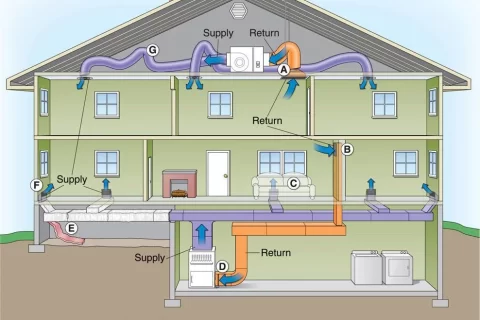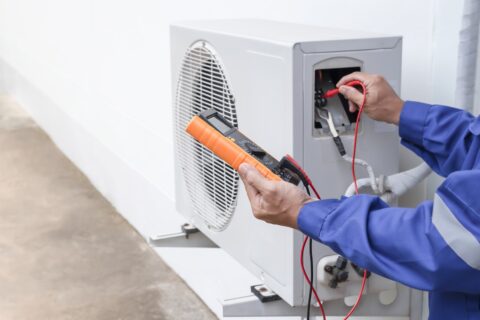HVAC Best Practices for Pet Owners – Keeping Your AC System Healthy
Did you know that 68% of U.S. households own a pet? This means millions of furry friends are living alongside their humans. As temperatures rise, keeping pets cool is crucial. Air conditioning plays a vital role in ensuring your pets stay comfortable and healthy, alongside vacuuming.
Pet owners must consider several factors when using AC, like temperature settings and airflow. Not all pets tolerate cold air the same way. Some breeds may need extra warmth while others thrive in cooler conditions; pet regularly and use an air filter. Understanding these ac considerations for pet owners can help create a safe environment for your beloved companions. Stay tuned to learn how to balance comfort for both you and your pets this summer.
Key Takeaways
-
Ensure your pets stay healthy by maintaining a comfortable indoor temperature with your AC, especially during hot weather.
-
Change your air filters regularly to improve air quality and reduce allergens that can affect your pets.
-
Keep AC vents and ducts clean to prevent dust and dander buildup, which can cause respiratory issues for both you and your pets.
-
Manage pet hair and dander by grooming your pets frequently and using lint rollers or vacuums designed for pet owners.
-
Consider installing a whole house air purifier to enhance air quality, making it safer for your pets to breathe.
-
Schedule routine AC maintenance to keep the system running efficiently and protect it from potential damage caused by curious pets.
Importance of AC for Pet Health
Temperature Control
Pets need a comfortable environment. A well-functioning air conditioning system helps regulate indoor temperatures. This is especially crucial during extreme weather conditions. High temperatures can lead to heatstroke in pets. Dogs and cats cannot cool down as humans do. They rely on their environment to stay safe.
During hot days, pets may become lethargic or anxious. They might seek out cooler areas in the house. If the AC fails, it can lead to serious health risks. Keeping the temperature stable promotes overall pet health. Owners should ensure their AC systems are regularly maintained for optimal performance.
Air Quality
Good air quality is essential for pets. Effective cooling systems help filter out dust and allergens. Poor air quality can cause respiratory issues in pets. Conditions like asthma or allergies can worsen without proper ventilation.
Regularly changing air filters in AC units can improve air quality. It also reduces the chances of respiratory problems. Pets with pre-existing conditions may suffer more if the air is not clean. Maintaining a good airflow ensures that pets breathe easier.
Energy Efficiency
Energy efficiency plays a role in pet comfort as well. An energy-efficient AC unit can keep costs down while maintaining a comfortable environment. This is important for long-term pet care.
High energy bills can deter owners from using the AC often enough. As a result, pets may suffer during hot months if the owner cannot afford to run it consistently. Investing in an efficient cooling system ensures that pets remain cool without breaking the bank.
Behavioral Changes
Temperature fluctuations can affect pet behavior. Pets may become irritable or stressed when it’s too hot or cold. A consistent indoor climate allows them to feel secure and relaxed.
Stressful environments can lead to behavioral issues such as excessive barking or scratching. Keeping the indoor climate stable helps prevent these problems.
Overall Well-being
A comfortable temperature and good air quality contribute significantly to a pet’s overall well-being. Happy pets are healthier pets. Owners should prioritize their pets’ needs by ensuring effective cooling systems are in place.
Regular maintenance of AC units is vital for this purpose. Checking refrigerant levels and cleaning ducts should be routine tasks. These actions will ensure that pets enjoy a safe and healthy living space throughout the year.
Regular Air Filter Changes
Establish Routine
Changing air filters monthly is crucial for maintaining clean air. This routine helps ensure optimal airflow in your home. Clean filters can significantly reduce allergens that may affect both pets and humans.
Pet owners should prioritize this task. Pets shed hair and dander, which can quickly clog filters. A clogged filter restricts airflow and makes the HVAC system work harder. This inefficiency can lead to higher energy bills.
Select HEPA Filters
HEPA filters are the best choice for pet owners. These filters trap smaller particles, including pet hair and dander. They capture up to 99.97% of particles as small as 0.3 microns. This capability greatly enhances indoor air quality.
Using HEPA filters can also help with odors from pets. Many filters come with activated carbon layers that absorb unwanted smells. Investing in these filters pays off by creating a fresher environment for everyone at home.
Monitor Filter Condition
Regularly checking filter condition is essential. Look for signs of clogging or dirt buildup. If a filter appears dirty or has reduced airflow, it’s time to change it, even if it hasn’t been a month yet.
Pets can produce a lot of hair and dander, especially during shedding seasons. During these times, more frequent changes may be necessary. Monitoring the HVAC filter will ensure your system operates efficiently.
Schedule Regular Maintenance
Scheduling regular HVAC maintenance visits is another smart move. Professionals can inspect and clean your system thoroughly. They can also check the air filters during these visits.
Technicians often recommend changing filters every month, especially in homes with pets. Following their advice helps maintain optimal performance of your HVAC system.
Simple Air Conditioning Tips
Implementing simple air conditioning tips can further improve air quality. Close windows and doors when the AC is running to keep outside pollutants out. Use exhaust fans in kitchens and bathrooms to reduce humidity levels.
Consider using an air purifier in addition to your HVAC system. An air purifier can provide extra filtration, especially in rooms where pets spend most of their time.
Clean AC Vents and Ducts
Regular Cleaning
Schedule regular cleaning of AC vents and ducts. This task helps eliminate pet hair buildup. Pet fur can clog the system and reduce air quality. It can also lead to inefficient cooling. Dust and allergens can circulate in your home if not cleaned regularly.
Cleaning should occur at least twice a year. Use a vacuum with a brush attachment for this task. Pay special attention to corners and crevices where fur may accumulate.
Inspect for Blockages
Inspect vents for blockages regularly. Blocked vents can restrict airflow, affecting your HVAC system’s performance. Check if furniture or other items obstruct any vents in your home.
Ensure that nothing is blocking the return air ducts as well. These ducts are crucial for maintaining proper airflow throughout your HVAC system. A blocked duct can cause the system to work harder, leading to higher energy bills.
Professional Services
Utilize professional cleaning services if necessary. These experts have the right tools and experience to clean your air conditioning system thoroughly. They can reach areas that are hard to access and remove stubborn debris effectively.
Professional HVAC providers often recommend annual inspections as part of their preventative HVAC maintenance steps. This visit allows them to check the entire system for potential issues, including dirty ducts.
Consider scheduling a professional cleaning if you notice increased dust or poor airflow. These signs indicate that your air conditioning system may need attention.
Benefits of Clean Vents
Clean vents provide several benefits. Improved air quality is one major advantage. Less dust and allergens mean a healthier living environment for both pets and people.
Efficient cooling is another benefit. A clean system operates more effectively, which can lower energy costs. Homeowners save money when their HVAC systems run efficiently.
Additional Tips
Here are some helpful air conditioning tips:
-
Change filters regularly to maintain airflow.
-
Keep the area around outdoor units clear.
-
Monitor humidity levels in your home.
-
Use ceiling fans to help circulate air.
These steps contribute to overall HVAC ownership satisfaction. They ensure that your home remains comfortable for everyone, including pets.
Manage Pet Hair and Dander
Grooming Routine
Implement a consistent grooming routine for pets. Regular brushing helps reduce excessive pet hair issues. It captures loose fur before it spreads around the home. Different pets may require different grooming tools. For example, short-haired pets might need less frequent brushing than long-haired ones. Aim to brush your furry friends at least once a week.
Bathing pets also plays a role in managing dander. A bath every few months can help keep their coat clean. Use pet-friendly shampoos to avoid skin irritation. This routine can significantly decrease pet fur buildup in your living space.
Cleaning Tools
Utilize lint rollers or pet-specific vacuums to keep surfaces clean. These tools quickly remove hair from furniture and clothing. A vacuum with a HEPA filter can trap small particles, including allergens. This is important for maintaining air quality in homes with pets.
Consider investing in an air purifier designed for pet owners. These devices filter out pet dander and other airborne particles. They improve indoor air quality, making it easier to breathe.
Family Education
Educate family members on cleaning common areas regularly. Everyone should participate in keeping the home tidy. Assign specific tasks like vacuuming or dusting to each person. This teamwork reduces the accumulation of allergens over time.
Encourage everyone to be mindful of where pets spend their time. Designate certain areas as pet-free zones, especially bedrooms. This limits the spread of dander and hair in those spaces.
Maintenance Tips
Establish a maintenance schedule for cleaning pet-related items. Wash pet bedding weekly to remove hair and dander. Clean toys and bowls regularly to prevent buildup of allergens.
Keep an eye on the air filter quality in your HVAC system. Change filters every 1-3 months, especially if you have multiple pets. A good air filter traps more particles, improving overall air quality.
Use Whole House Air Purifier
Continuous Filtration
Investing in a whole-house air purifier is a smart move for pet owners. It works to continuously filter out pet hair and dander from the indoor air. This helps improve overall home air quality. Many systems integrate with existing home HVAC systems. They circulate filtered air throughout the house.
These air purifiers can capture particles as small as 0.3 microns. This includes allergens like dust, pollen, and pet dander. The American Lung Association states that good indoor air quality is essential for health. A whole-house system ensures cleaner air in every room.
Strategic Placement
Positioning the air purifier strategically enhances its effectiveness. Place it near common areas where pets spend time. Living rooms and bedrooms are ideal spots. This allows the system to work efficiently in filtering out contaminants.
Consider the layout of your home. Open floor plans may require multiple units or a larger system. Ensure that the airflow isn’t blocked by furniture or walls. Proper placement maximizes the purifier’s ability to clean the air.
Regular Maintenance
Regular maintenance is crucial for optimal operation. Replace filters according to the manufacturer’s recommendations. Clogged filters reduce efficiency and can even cause damage to the unit.
Cleaning the unit itself is also important. Dust can accumulate on external parts, affecting performance. Some systems have washable filters, while others require replacements.
Schedule routine checks for your whole-house air purifier. Keeping it in top shape ensures it effectively removes pollutants from your home’s indoor air.
Cost Considerations
While a whole-house air purifier may seem costly upfront, it provides long-term benefits. Improved indoor air quality leads to better health outcomes for you and your pets. Fewer allergy symptoms mean fewer doctor visits and medication costs.
Many models qualify for energy efficiency rebates, reducing initial expenses. Weigh these factors when considering your investment.

Benefits for Pets
Pets benefit greatly from cleaner indoor air too. Allergens can irritate their respiratory systems just as much as ours. A whole-house air purifier helps create a healthier environment for them.
Moreover, pets with allergies may experience relief from symptoms such as sneezing or itching. This leads to happier and more comfortable pets at home.
Keep Pets Away from AC Units
Designate Safe Zones
Create a clear safe zone around your outdoor air conditioning unit. This area should be free of toys, debris, and other distractions. By doing this, you protect both your pets and the air conditioning unit. Pets can cause damage by chewing on wires or components. A designated zone helps prevent this.
Use fencing or natural barriers to keep pets away from the unit. This simple step can save you from costly repairs. It also ensures that your pets stay safe from potential hazards near the air conditioning unit.
Supervise Pets
Always supervise pets when they are near an AC unit. Animals can be curious, especially about new objects in their environment. They might want to investigate the outdoor air conditioner out of curiosity. Chewing on wires can lead to serious injuries for them and malfunction for the unit.
If you notice your pet getting too close, gently redirect them. Teach them to respect the boundaries around the air conditioning unit. This supervision is especially important during hot weather when pets may seek cool spots near the outside air conditioning unit.
Educate Household Members
Educate everyone in your household about keeping the area around the AC unit clean and safe. Explain why it is essential to remove toys and other items that could attract pets. Toys left lying around can encourage pets to play near the outdoor air conditioner unit.
Involve children in this process. Teach them how to maintain a clutter-free space around the AC unit. Show them how debris can cause clogs or damage, which can lead to an overworked air conditioner.
Benefits of Proper Care
Taking these precautions offers several benefits. First, it protects your pets from injury caused by electrical components. Second, it keeps your air conditioning unit functioning properly without interruptions from clogs or damage. Third, it teaches responsibility among family members regarding pet care and home maintenance.
Proper care leads to fewer repairs and a longer lifespan for your AC system. Regular checks on the area around the outdoor unit help catch any issues early.
By ensuring a safe environment for both your pets and your air conditioning system, you create a win-win situation. A little effort goes a long way in maintaining peace at home while keeping everyone safe.
Schedule Routine AC Maintenance
Seasonal Checks
Book seasonal HVAC maintenance checks. These checks ensure the cooling system runs at peak efficiency. Technicians inspect filters, coils, and refrigerant levels. They also check for any wear and tear that could affect performance. Regular checks help prevent breakdowns during hot weather.
Pet owners should mention any specific concerns during these visits. Pets can affect AC systems in various ways. For instance, pet hair can clog filters quickly. This can reduce airflow and efficiency. Discussing these issues with the technician allows for tailored solutions.
Technician Communication
Communicate openly with your HVAC technician. Share any pet-related concerns during maintenance visits. Mention if your pets shed a lot or have allergies. The technician can offer advice on filter types suited for homes with pets. They may recommend high-efficiency filters to capture more allergens.
Understanding how pets impact the AC system is crucial. Pets often bring dirt and dander into the home. This can lead to more frequent maintenance needs. Keeping the lines of communication open helps address these challenges effectively.
Document Maintenance
Maintain a detailed record of all HVAC maintenance activities. Document service dates and repairs done on the system. This record helps track the health of the AC unit over time. It also provides valuable information for future maintenance.
A well-documented history allows homeowners to spot patterns in repairs. If certain issues arise repeatedly, it may indicate a deeper problem. Tracking this information can help technicians diagnose issues faster in future visits.
Benefits of Regular Maintenance
Regular HVAC maintenance offers several benefits for pet owners:
-
Improved air quality: Frequent filter changes reduce allergens.
-
Enhanced efficiency: A well-maintained system uses less energy.
-
Extended lifespan: Regular checks can prolong the life of the unit.
-
Fewer emergency repairs: Routine care minimizes unexpected breakdowns.
By investing in an HVAC maintenance plan, pet owners ensure a comfortable environment for their furry friends.
Scheduling Tips
Create a routine HVAC maintenance schedule. Aim for at least two checks per year, ideally before summer and winter seasons. This proactive approach helps prepare your system for temperature extremes.
Consider scheduling these checks when you are home. Being present allows you to discuss any concerns directly with the technician.
Set Optimal Temperature and Humidity
Ideal Temperature
Pets require a comfortable environment to thrive. The ideal temperature range varies by breed and size. Generally, most pets feel best in temperatures between 68°F and 72°F. Smaller breeds or short-haired animals might prefer the warmer end of this range. Larger or long-haired pets can tolerate cooler temperatures.
e specific breeds have unique needs. For example, Bulldogs struggle with heat due to their short snouts. Keeping them cooler is essential during hot days. On the other hand, Siberian Huskies do well in colder environments but should never be left outside in extreme cold for too long.
Monitor Humidity
Humidity plays a crucial role in pet comfort. High humidity can lead to discomfort and health issues for pets. It creates a breeding ground for mold and bacteria. This can affect both pet health and indoor air quality.
Maintaining humidity levels between 30% and 50% is ideal. Use a hygrometer to monitor these levels easily. If humidity rises above this range, consider using a dehumidifier. It helps reduce moisture in the air, protecting your pets from potential health risks.
Adjust Thermostat Settings
Extreme weather requires careful attention to thermostat settings. During summer months, high temperatures can cause heat stress in pets. Signs include excessive panting, drooling, or lethargy. Adjust the thermostat to keep indoor temperatures cool during these times.
In winter, cold weather poses risks too. Pets can suffer from hypothermia if left in frigid conditions. Ensure your thermostat keeps indoor spaces warm enough for comfort. A temperature around 68°F is often sufficient.
Quality Air Circulation
Good air circulation enhances comfort for pets. Stagnant air can lead to unpleasant odors and increased allergens. Utilize fans alongside your AC system to improve airflow in your home.
Regular cleaning of air filters also promotes better air quality. Dirty filters can restrict airflow and allow dust buildup. This impacts not only human health but also that of your pets.
Protect From Heat Stress
Heat stress can be fatal for pets if not addressed quickly. Always provide plenty of fresh water and shade when outside during hot days. Monitor them closely for signs of overheating.
Indoor safety measures are equally important. Keep windows closed on hot days to prevent heat buildup inside the house. Use shades or curtains to block direct sunlight from heating up rooms where pets spend time.
Protect AC Systems from Pets
Install Barriers
Installing barriers or fencing around outdoor units is crucial. Pets often explore their surroundings. They might see the outdoor AC unit as a play area. A simple fence can keep pets away. It protects the system from scratches and damage.
e professionals suggest using sturdy materials for barriers. Chain-link fences work well. So do wooden or vinyl fences. Ensure the barrier is tall enough to prevent jumping.
Regularly check these barriers for any gaps or weaknesses. Repair them immediately to maintain protection.
Use Protective Covers
Using protective covers during off-seasons is another smart move. Outdoor equipment faces harsh weather conditions. Rain, snow, and sun can cause wear and tear. Covers shield the unit from debris and moisture.
Professionals recommend breathable covers. These prevent moisture buildup while keeping dirt out. Make sure the cover fits snugly over the unit. Loose covers can blow away or allow pests inside.
Store the cover properly when not in use. This prevents damage to the cover itself.
Educate Family Members
Educating family members about protecting AC systems is essential. Everyone in the household should understand the risks pets pose to these systems. Discuss the importance of keeping pets away from outdoor units.
Involve children in this education process. Teach them to recognize signs of potential damage caused by pets. Explain how curious behavior can lead to costly repairs.
Create a routine for checking the AC unit regularly. This helps spot any signs of pet-related issues early on. Encourage family members to report anything unusual they see.
Professional Maintenance
Seeking help from professionals can also be beneficial. Schedule regular maintenance checks for your AC unit. Technicians can identify potential problems before they escalate.
During these visits, mention any concerns related to pets. Professionals can provide tailored advice on safeguarding your system.
Consideraciones Finales
Keeping your pets comfortable and healthy in a cool environment is crucial. You’ve learned how to maintain your AC system, manage pet hair, and protect your furry friends from potential hazards. Each step plays a vital role in ensuring optimal air quality and temperature for your pets.
Take action today. Regular maintenance and smart practices will help you create a safe haven for your pets. Prioritize their comfort and health by implementing these strategies. Your pets deserve the best, so don’t wait—start making changes now for a happier, healthier home environment.
Frequently Asked Questions
What is the importance of AC for pet health?
Air conditioning helps maintain a comfortable environment for pets. It regulates temperature and humidity, preventing heat stress and respiratory issues. A cool space ensures your pets remain healthy and happy.
How often should I change my AC air filters?
You should change your AC air filters every 1-3 months. Frequent changes improve air quality by reducing allergens like pet dander and hair, promoting a healthier home for both you and your pets.
Can I clean AC vents and ducts myself?
While you can clean some parts of your AC system, it’s best to hire professionals for duct cleaning. They have the tools and expertise to remove deep-seated dust and allergens effectively, ensuring better air quality.
How do I manage pet hair and dander in my home?
Regular grooming reduces shedding, while vacuuming with a HEPA filter helps capture pet hair and dander. Consider using lint rollers on furniture to keep surfaces clean and allergen-free.
Are whole house air purifiers effective for pet owners?
Yes, whole house air purifiers are highly effective. They filter out pet dander, hair, and other allergens from the air, improving overall indoor air quality and benefiting both pets and humans.
How can I keep pets away from AC units?
Use barriers or gates to restrict access to AC units. Training your pets to stay away from these areas also helps prevent damage to the system and keeps them safe from any hazards.
Why is routine AC maintenance important for pet owners?
Routine AC maintenance ensures optimal performance and longevity of your system. Regular checks prevent breakdowns, reduce allergens, and maintain a comfortable environment for your pets year-round.


